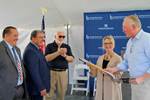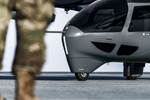Cranfield Aerospace Solutions unveils new zero-emissions aircraft facilities
Cranfield Aerospace Solutions unveils refurbished facilities for development of future hydrogen-powered aircraft.
Share
Read Next

Cranfield Aerospace Solutions (CAeS, Cranfield, U.K.) has unveiled newly refurbished facilities for the development of zero-emissions aircraft. The hangar and R&D facility are located at Cranfield University campus. The new facility, leased by CAeS, is part of Cranfield University’s decarbonization plan, with significant investment into reducing the building’s carbon footprint.
The modernized and more environmentally-friendly hangar will be used to modify CAeS’ Britten-Norman Islander, bound for conversion to a hydrogen-electric propulsion system for entry into service in 2026. It will also be used by CAeS to develop the procedures and processes required for the maintenance of future hydrogen-powered aircraft, while still maintaining its conventional MRO function which specializes in wide-bodied and light aircraft such as Diamond DA 40/42 Series and Piper Singles and Twin Piston Engine Series.
“This modernized hangar becomes a classroom of possibilities, where we will not only deliver the intricacies of zero emissions propulsion but also pioneer maintenance procedures for hydrogen-powered aircraft,” ways CAeS CEO Paul Hutton. “Our engineers and technologists, fuelled by curiosity and a passion for sustainability, stand ready to lead the charge at the most exciting stage of our growth yet.”
Related Content
-
“Structured air” TPS safeguards composite structures
Powered by an 85% air/15% pure polyimide aerogel, Blueshift’s novel material system protects structures during transient thermal events from -200°C to beyond 2400°C for rockets, battery boxes and more.
-
Industrializing additive manufacturing in the defense/aerospace sector
GA-ASI demonstrates a path forward for the use of additive technologies for composite tooling, flight-qualified parts.
-
The potential for thermoplastic composite nacelles
Collins Aerospace draws on global team, decades of experience to demonstrate large, curved AFP and welded structures for the next generation of aircraft.



